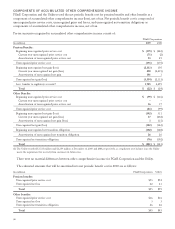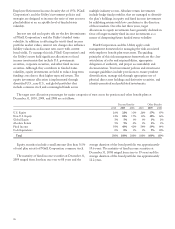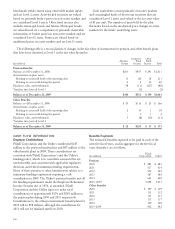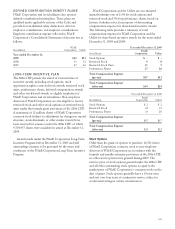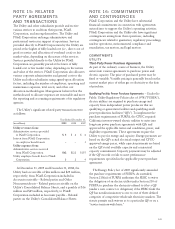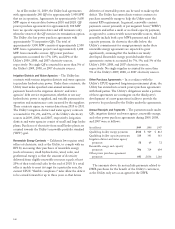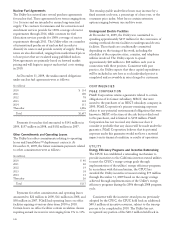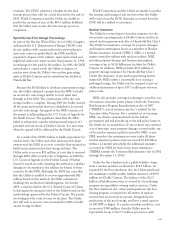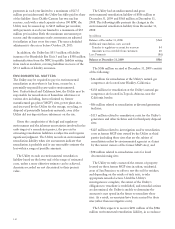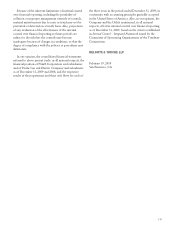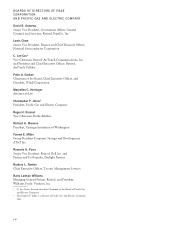PG&E 2009 Annual Report Download - page 110
Download and view the complete annual report
Please find page 110 of the 2009 PG&E annual report below. You can navigate through the pages in the report by either clicking on the pages listed below, or by using the keyword search tool below to find specific information within the annual report.
As of December 31, 2009, the Utility had agreements
with approximately 240 QFs for approximately 3,900 MW
that are in operation. Agreements for approximately 3,600
MW expire at various dates between 2010 and 2028. QF
power purchase agreements for approximately 300 MW
have no specific expiration dates and will terminate only
when the owner of the QF exercises its termination option.
The Utility also has power purchase agreements with
approximately 75 inoperative QFs. The total of
approximately 3,900 MW consists of approximately 2,500
MW from cogeneration projects and approximately 1,400
MW from renewable sources. QF power purchase
agreements accounted for 17%, 18%, and 20% of the
Utility’s 2009, 2008, and 2007 electricity sources,
respectively. No single QF accounted for more than 5% of
the Utility’s 2009, 2008, or 2007 electricity sources.
Irrigation Districts and Water Agencies — The Utility has
contracts with various irrigation districts and water agencies
to purchase hydroelectric power. Under these contracts, the
Utility must make specified semi-annual minimum
payments based on the irrigation districts’ and water
agencies’ debt service requirements, whether or not any
hydroelectric power is supplied, and variable payments for
operation and maintenance costs incurred by the suppliers.
These contracts expire on various dates from 2010 to 2031.
The Utility’s irrigation district and water agency contracts
accounted for 3%, 2%, and 3%, of the Utility’s electricity
sources in 2009, 2008, and 2007, respectively. Irrigation
districts and water agencies consist of small and large hydro
plants. Purchases of electricity from small hydro plants are
counted towards the Utility’s renewable portfolio standard
(“RPS”) goal.
Renewable Energy Contracts — California law requires retail
sellers of electricity, such as the Utility, to comply with an
RPS by increasing their purchases of renewable energy
(such as biomass, small hydroelectric, wind, solar, and
geothermal energy), so that the amount of electricity
delivered from eligible renewable resources equals at least
20% of their total retail sales by the end of 2010. If a retail
seller is unable to meet its target for a particular year, the
current CPUC “flexible compliance” rules allow the deficit
to be carried forward for up to three years so that future
deliveries of renewable power can be used to make up the
deficit. The Utility has entered into various contracts to
purchase renewable energy to help the Utility meet the
current RPS requirement. In general, renewable contract
payments consist primarily of per megawatt hour (“MWh”)
payments and either a small or no fixed capacity payment,
as opposed to contracts with non-renewable sources, which
generally include both a per MWh payment and a fixed
capacity payment. As shown in the table below, the
Utility’s commitments for energy payments under these
renewable energy agreements are expected to grow
significantly, assuming that the facilities are timely
developed. Renewable energy provided under these
agreements contracts accounted for 7%, 5%, and 3% of the
Utility’s 2009, 2008, and 2007 electricity sources,
respectively. No single supplier accounted for more than
5% of the Utility’s 2009, 2008, or 2007 electricity sources.
Other Purchase Agreements — In accordance with the
Utility’s CPUC-approved long-term procurement plans, the
Utility has entered into several power purchase agreements
with third parties. The Utility’s obligations under a portion
of these agreements are contingent on the third party’s
development of a new generation facility to provide the
power to be purchased by the Utility under the agreements.
Annual Receipts and Payments — The payments made under
QFs, irrigation district and water agency, renewable energy,
and other power purchase agreements during 2009, 2008,
and 2007 were as follows:
(in millions) 2009 2008 2007
Qualifying facility energy payments $532 $ 969 $ 812
Qualifying facility capacity payments 334 343 363
Irrigation district and water agency
payments 58 69 72
Renewable energy and capacity
payments 706 714 604
Other power purchase agreement
payments 643 2,036 1,166
The amounts above do not include payments related to
DWR purchases for the benefit of the Utility’s customers,
as the Utility only acts as an agent for the DWR.
106


